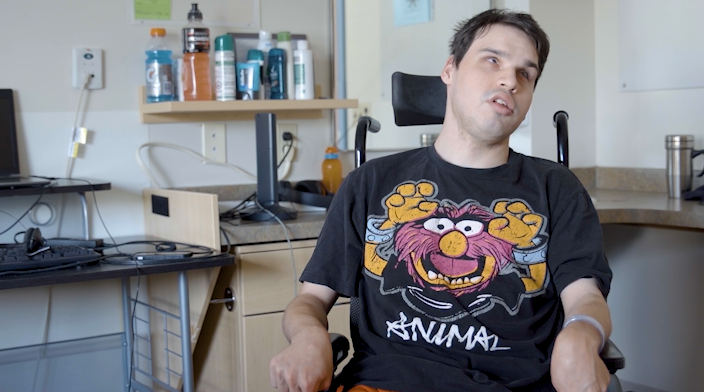Tyson Sylvester launched a human rights complaint against the province's health authorities, frustrated by the lack of services provided to adults with physical disabilities.
PILC and CPMB were eager to drum up interest and the public's disapproval for these inadequate services, putting pressure on the province's health authorities to respond to the human rights complaints filed by these two individuals PILC was representing.
The isolation and lack of fundamental care faced by adults with physical disabilities was new to most of us at the agency – and took on even more emotional depth when hearing about the injustice from Tyson, Amy and her mother, Charlene. Hearing their stories made our own team uncomfortable, angry, emotional and empathetic to their situation. We knew the public was likely to react similarly if confronted with this reality.
With his consent, we locked Tyson in a jail cell in the middle of a downtown park.
Locking a young, vision-impaired, wheelchair-bound man in a jail cell came with a certain amount of risk, and we experienced some push-back as we began to put the pieces in place. However, we accepted the risk for two reasons:
We filmed Tyson making the issue visible to the public for the first time. He locked himself in a jail cell in the middle of Winnipeg's Old Market Square, a busy spot for the artistic, business and post-secondary communities downtown on their lunch hour.
Staging a real and immersive interaction with Tyson, the issue was poignantly captured by his own lived experience (in pre-recorded audio) – and by his public act. Though visually discomforting, people were encouraged to walk up to the jail cell and listen to a recording of Tyson telling his story, atoning the narrative to one of empowerment and advocacy.
The impact this had on the individuals who engaged with Tyson didn't stop then, as the event earned media attention, and was recorded and edited into a campaign video, cut to Tyson's words. The emotional reactions lent to the narrative that society is missing out on these individuals' contributions, in addition to the grave impact it has on their lives.
The video gained plenty of organic traction, reaching over 117,000 people on Facebook, earning over 75,000 views, and – most poignantly – over 1,300 shares with like-minded people wishing to help spread the message of this injustice and align with the cause.
What's the safest way to present an immersive event filled with unknowns?





